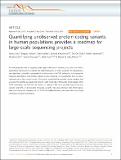Quantifying unobserved protein-coding variants in human populations provides a roadmap for large-scale sequencing projects
Author(s)
Zou, James; Valiant, Gregory; Valiant, Paul; Karczewski, Konrad; Chan, Siu On; Samocha, Kaitlin; Lek, Monkol; MacArthur, Daniel G.; Sunyaev, Shamil R.; Daly, Mark J.; ... Show more Show less
DownloadQuantifying unobserved.pdf (227.7Kb)
PUBLISHER_CC
Publisher with Creative Commons License
Creative Commons Attribution
Terms of use
Metadata
Show full item recordAbstract
As new proposals aim to sequence ever larger collection of humans, it is critical to have a quantitative framework to evaluate the statistical power of these projects. We developed a new algorithm, UnseenEst, and applied it to the exomes of 60,706 individuals to estimate the frequency distribution of all protein-coding variants, including rare variants that have not been observed yet in the current cohorts. Our results quantified the number of new variants that we expect to identify as sequencing cohorts reach hundreds of thousands of individuals. With 500K individuals, we find that we expect to capture 7.5% of all possible loss-of-function variants and 12% of all possible missense variants. We also estimate that 2,900 genes have loss-of-function frequency of <0.00001 in healthy humans, consistent with very strong intolerance to gene inactivation.
Date issued
2016-10Department
Massachusetts Institute of Technology. Institute for Medical Engineering & Science; Broad Institute of MIT and Harvard; Harvard University--MIT Division of Health Sciences and TechnologyJournal
Nature Communications
Publisher
Nature Publishing Group
Citation
Zou, James; Valiant, Gregory; Valiant, Paul; Karczewski, Konrad; Chan, Siu On; Samocha, Kaitlin; Lek, Monkol; Sunyaev, Shamil; Daly, Mark and MacArthur, Daniel G. “Quantifying Unobserved Protein-Coding Variants in Human Populations Provides a Roadmap for Large-Scale Sequencing Projects.” Nature Communications 7 (October 2016): 13293. © 2017 Macmillan Publishers Limited, part of Springer Nature
Version: Final published version
ISSN
2041-1723